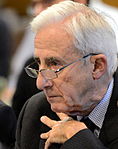From Wikipedia, the free encyclopedia
1984 Luxembourg general election
First party
Second party
Third party
Leader
Jacques Santer
Jacques Poos
Colette Flesch
Party
CSV
LSAP
DP
Last election
24 seats, 36.4
14 seats, 22.5%
15 seats, 21.9%
Seats won
25
21
14
Seat change
Popular vote
1,148,085
1,104,740
614,627
Percentage
36.7%
31.8%
20.4%
Swing
General elections were held in Luxembourg on 17 June 1984.[1] Christian Social People's Party remained the largest party, winning 25 of the 64 seats in the Chamber of Deputies .[2] Luxembourg Socialist Workers' Party , the Santer-Poos government .[3]
Results
Party
Votes
%[a]
Seats
+/–
style="background-color: Template:Christian Social People's Party/meta/color " |
Christian Social People's Party 1,148,085
36.7
25
+1
style="background-color: Template:Luxembourg Socialist Workers' Party/meta/color " |
Luxembourg Socialist Workers' Party 1,104,740
31.8
21
+7
style="background-color: Template:Democratic Party (Luxembourg)/meta/color " |
Democratic Party 614,627
20.4
14
–1
style="background-color: Template:Communist Party of Luxembourg/meta/color " |
Communist Party of Luxembourg 165,960
4.4
2
0
style="background-color: Template:The Greens (Luxembourg)/meta/color " |
Green Alternative 169,862
4.2
2
New
Independent Socialist Party 81,002
2.4
0
–1
Others
6,686
0.2
0
–
Invalid/blank votes
11,657
–
–
–
Total 191,651 100 64 +5
Registered voters/turnout
215,792
88.8
–
–
Source: Nohlen & Stöver
a [4]
Popular Vote
CSV
36.7%
LSAP
31.8%
DP
20.4%
KPL
4.4%
GA
4.2%
OSP
2.4%
References




